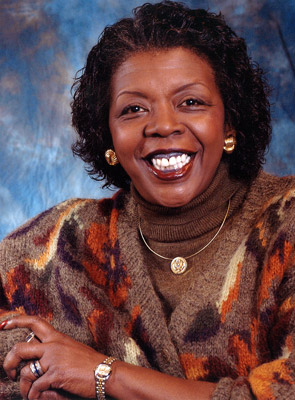Stephanie Tubbs Jones
Representative, 1999–2008, Democrat from Ohio
 Image courtesy of Office of the Clerk, U.S. House of Representatives
Image courtesy of Office of the Clerk, U.S. House of RepresentativesStephanie Tubbs Jones won election to the U.S. House of Representatives in 1998, becoming the first African-American woman to represent Ohio in the U.S. Congress. In the 110th Congress (2007–2009), Jones became the first African-American woman to chair a standing House committee.1 Representative Jones, who chaired the Standards of Official Conduct Committee and held a seat on the influential Ways and Means Committee, focused on the economic issues affecting her Cleveland-centered district: financial literacy, access to health care, retirement security, and education.
Stephanie Tubbs was born in Cleveland, Ohio, on September 10, 1949, the youngest of three daughters raised by Mary Tubbs, a factory worker, and Andrew Tubbs, an airline skycap. Raised in Cleveland’s Glenville neighborhood, Stephanie Tubbs graduated from Collinwood High School, earning 10 academic and athletic awards. At Case Western Reserve University, Tubbs founded the African-American Students Association and, in 1971, earned a B.A. in sociology with a minor in psychology. “All my life I had wanted to help others, and I had been active in helping others,” she recalled. “I was always interested in service. In my day, the college watchword was relevant. . . . With a law degree, I thought I could bring about relevant change in the world.”2 She enrolled in the Case Western University Law School and graduated in 1974 with a J.D. Tubbs then served as the assistant general counsel for the equal opportunity administrator of the northeast Ohio regional sewer district. In 1976, Tubbs married Mervyn Jones. They raised a son, Mervyn. Stephanie Tubbs Jones later worked as an assistant Cuyahoga County prosecutor and trial attorney for the Cleveland district equal employment opportunity commission. When Jones and several friends worked on a successful political campaign in 1979, the group pledged to select one among them to promote for public office. Noting a lack of minority members on the bench, they chose Jones, who eventually won election as a judge on the Cleveland municipal court. Ohio Governor Richard Celeste appointed Jones to the Cuyahoga County court of common pleas, where she served from 1983 to 1991. In 1992, she was appointed the Cuyahoga County prosecutor, making her the state’s first African-American prosecutor and the only black woman prosecutor in a major U.S. city. Jones was re-elected twice.3
In 1998, when 30-year veteran U.S. Representative Louis Stokes retired from his Ohio district seat, Jones entered the Democratic primary to succeed him. She ran on the basis of her 17-year career in public office in the district and on her well-established political connection to constituents.4 Capturing 51 percent of the vote among five primary candidates, she later won 80 percent in the general election. Jones faced no serious challenges in her four re-election bids, winning by 75 percent or more of the vote.5 In 2006, Jones won with 83 percent.6
When she took her seat in the 106th Congress (1999–2001), Jones received assignments on the Banking and Financial Services (later renamed Financial Services) and Small Business committees. In the 107th Congress (2001–2003), in addition to serving on those two panels, she served on the Standards of Official Conduct Committee, which oversees House ethics guidelines for Members and staff. In the 108th Congress (2003–2005), Jones won a seat on the prestigious Ways and Means Committee, which has jurisdiction over tax law.7
Representative Jones’s district encompassed some of Cleveland’s most affluent suburbs and parts of poor, inner-city neighborhoods. Her seat on Financial Services helped her secure funding for business and housing development. In the 108th Congress, Jones chaired the Congressional Black Caucus Housing Task Force, investigating allegations against subprime lenders and introducing legislation against predatory lenders.8 Jones’s seat on Ways and Means enabled her to focus legislative efforts on shoring up Social Security and Medicare, pension law, and long-term care.
Jones also took a legislative interest in children’s issues, health, and education. She authored and passed the Child Abuse prevention and enforcement Act of 1999 to increase training funds for child-protection workers through money generated from bail bonds, fines, and forfeited assets. In the 107th through the 109th Congresses (2001–2007), Representative Jones introduced the Uterine Fibroids Research and Education Act and also authored the Campus Fire Prevention Act to provide federal funds to equip college housing with fire suppression equipment. In 2005, Jones introduced the Count Every Vote Act to improve electronic voting systems. Additionally, she authored legislation to clarify the legal status of cash balance pension plans. In the 109th Congress, she chaired the Congressional Black Caucus Retirement Security Task Force.
Representative Jones died suddenly of a brain aneurism on August 20, 2008. She was succeeded by Marcia L. Fudge—one of her former aides and the mayor of Warrensville Heights, Ohio—in a special election on November 18, 2008.
Further Reading
Fenno, Richard F. Going Home: Black Representatives and Their Constituents (Chicago: University of Chicago Press, 2003).
“Jones, Stephanie Tubbs,” Biographical Directory of the U.S. Congress, 1774–Present, http://bioguide.congress.gov/scripts/biodisplay.pl?index=J000284.
Footnotes
- Representative Juanita Millender-McDonald of California became Chairwoman of the House Administration Committee at the same time.
- Richard Fenno, Going Home: Black Representatives and Their Constituents (Chicago: University of Chicago Press, 2003): 193.
- “Stephanie Tubbs Jones,” Contemporary Black Biography, volume 24 (Detroit, MI: Gale Research Inc., 2000).
- Fenno, Going Home: 196–198; 201.
- Ibid., 203.
- “Election Statistics, 1920 to Present,” available at http://clerk.house.gov/member_info/electionInfo/index.html.
- Politics in America, 2008 (Washington, DC: Congressional Quarterly Inc., 2007): 800.
- Politics in America, 2002 (Washington, DC: Congressional Quarterly Inc., 2001): 796–797.

